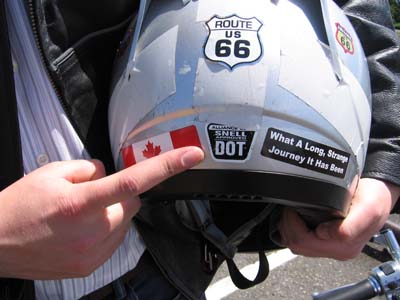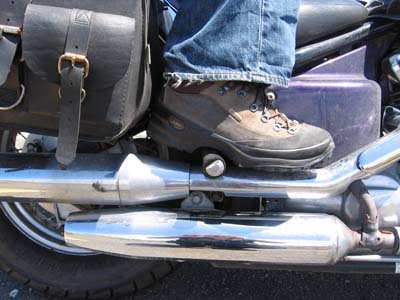Motorcycle safety - the rider and the gear
- Overview
- Motorcycle Safety Laws
- Protecting Your Head – Helmet Requirements
- Police Inspections at the Roadside
- Sitting Safely – Seating Requirements
- Motorcycle Related Fines and Penalty Points
- Resources
Overview
Motorcyclists are over-represented in road trauma statistics. In British Columbia motorcycles are estimated to make up about three per cent of insured vehicles, yet motorcycles are involved in approximately ten per cent of road fatalities. Between 1996 and 2010, motorcycle fatalities increased 57 per cent. The fatality rate for young drivers under 25 years of age is on average 15 times higher than drivers over 25 years of age.
Motorcyclists are considered vulnerable road users for a number of reasons:
- Motorcycles have only two points of contact with the road, requiring skillful control on the part of the driver to maintain balance, speed and traction to prevent collisions
- Motorcycles are small and narrow, so other road users have more difficulty seeing motorcycles and estimating their distance and speed
- Motorcycles offer much less impact protection than being inside a passenger vehicle
- Some motorcycles are built for speed and performance levels significantly higher than automobiles
Motorcycle Safety Laws
On June 1, 2012, amendments to the Motor Vehicle Act and supporting regulations will be brought into force. These changes to the law are as follows:
- All motorcyclists and motorcycle passengers in British Columbia must wear a motorcycle safety helmet that meets designated safety standards
- All motorcyclists and passengers may be required to produce their helmets on demand to a peace officer
- The operator of a motorcycle must be seated astride the driver's seat
- Passengers must be seated behind the operator, astride the passenger's seat with feet on foot pegs or floorboards, or be properly seated in a side car
- The motorcycle operator is responsible for ensuring any passengers younger than 16 are properly helmeted and seated
Protecting Your Head – Helmet Requirements
Motorcycle helmets can reduce the likelihood of a crash fatality and are also found to be very effective in preventing brain injuries.
In British Columbia, motorcycle drivers and passengers are required to wear a motorcycle safety helmet that meets one of the following safety standards (and the helmet needs to display the proper certification label):
- DOT: conformance with the Federal Motor Vehicle Safety Standard No. 218; Motorcycle helmets (United States of America), also known as FMVSS 218 (49CFR571.218)
- Snell M2005, M2010 or M2015: certification in accordance with the Snell Memorial Foundation 2005, 2010 or 2015 Standard for Protective Headgear for Use with Motorcycles and Other Motorized Vehicles
- ECE: approved in accordance with the United Nations Economic Commission for Europe (ECE) Regulation No. 22
The safety helmet needs to display the proper certification label. Detailed requirements and label images are provided below.
Standards for helmet safety are set by a series of tests performed on these critical elements:
- Impact management – how well the helmet protects against collisions with large objects
- Helmet position stability – whether the helmet will stay in place during an impact
- Straps – whether the chin straps and hardware are strong enough to hold the helmet on during impact
- Extent of protection – the area of the head protected by the helmet
A motorcycle helmet that meets these standards contains a rigid head covering that consists of a strong, stiff outer shell and a crushable liner. The stiff outer shell must protect the head by distributing the impact throughout the surface of the helmet, and the crushable liner must protect the head by absorbing the energy of the impact.
Compliance with other standards – such as Canada Standards Association (CSA), British Standards Institute (BSI) or the American National Standards Institute (ANSI) – while not prohibited, does not mean your helmet is legal. British Columbia has not adopted these standards because they are not available to the public free of charge. The Province is committed to ensuring the standards required by law not only represent the cutting edge of safety industry technical knowledge, but are also available to all British Columbians at no cost.
Full-face helmets and visors are not required and riders are free to choose any helmet colour they prefer. However, eye protection and brightly-coloured helmets are strongly recommended to help prevent collisions, injuries and fatalities. Uncertified, novelty beanies do not meet the requirements.
Approved Helmet Standard and Label
DOT Certification
The symbol DOT, constitutes the manufacturer's certification that the helmet conforms to the applicable Federal motor vehicle safety standards. This symbol needs to appear on the outer surface of the helmet, in a color that contrasts with the background color of the helmet. Letters are at least one centimetre (3/8 inch) high, centred laterally with the horizontal centreline of the symbol located a minimum of 2.9 centimetres (1 1/8 inches) and a maximum of 3.5 centimetres (1 3/8 inches) from the bottom edge of the helmet.

Snell 2005, 2010 and 2015 Certifications
Each helmet shall include one of the Snell Memorial Foundations serialized certification labels. The Snell certification label can be placed on either the inside or outside of the helmet.



ECE (Economic Commission for Europe) Certification
An ECE label means the helmet is approved in accordance with the United Nations Economic Commission for Europe Regulation No. 22.05. The symbol for this approval is a circle surrounding the letter 'E' followed by the identification number of the country that has granted approval.
In addition, the following information is represented by the approval label.
The approval number followed by a letter identifying helmet characteristics:
- J - if helmet does not have a lower face cover
- P - if helmet has a protective lower face cover
- NP - if the helmet has a 'non-protective' lower face cover
This is then followed by a production serial number.

Police Inspections at the Roadside
If police have probable cause to suspect the motorcycle driver or passenger are not using an approved helmet, police are authorized to inspect helmets at the roadside to ensure they meet specified requirements. Inspected helmets that do not meet the approved standards are subject to seizure. If the motorcycle can’t be parked legally or safely after such helmet seizure, a peace officer has authority to have the vehicle towed at the owner’s expense.
The power to seize helmets may be exercised only when the officer has reason to believe a helmet does not meet regulatory requirements, which can be determined by inspecting the helmet for safety certification labels.
During such a seizure, peace officers are subject to existing procedures required under the Offence Act which ensure fairness regarding how the property is handled and determining who retains the property after any relevant court proceedings or processes.
Sitting Safely – Seating Requirements
Under the motorcycle safety laws the seating requirements are as follows:
- The operator of a motorcycle must be seated astride the driver’s seat
- Passengers must be seated behind the operator astride the passenger’s seat with their feet on foot pegs or the floorboards at all times (even when the motorcycle is stopped – e.g., at an intersection), or be properly seated in a side car.
- As the motorcycle operator, you are responsible to ensure passengers younger than 16 are properly seated. Any passengers, including children, who can’t reach the foot pegs or floorboards are not permitted to ride as passengers on your motorcycle
Image below shows placement of feet on foot pegs.

Motorcycle-related Fines and Penalty Points
| Motor Vehicle Act (MVA) Section | Description | Fine | Points |
|---|---|---|---|
| 194(1) | Operate motorcycle – not on seat | $121 | 2 |
| 194(2)(a) | Passenger unlawfully on motorcycle | $109 | 0 |
| 194(2)(b) | Motorcycle passenger not lawfully seated | $109 | 0 |
| 194(2)(c) | Fail to use foot pegs or floorboards | $109 | 0 |
| 194(3) | Ride motorcycle without required helmet | $138 | 0 |
| 194(4)(a) | Permit passenger under 16 to be unlawfully seated | $109 | 2 |
| 194(4)(b) | Permit passenger under 16 to ride without a helmet | $138 | 0 |
| 194(9) | Obstruct a peace officer | $276 | 0 |
| 194(10) | Operate motorcycle more than two abreast | $109 | 2 |
| MVA Regulations Section | Description | Fine | Points |
|---|---|---|---|
| Fine Increase 3.02 | Improper Display of Plate | $230 | 0 |
| Fine Increase 3.03 | Illegal Plate | $230 | 0 |
NOTE: Violation of seating laws will result in vehicle impoundment and fines. For information on driving infraction impoundments see Notice of Impoundment information on the Vehicle Impoundment page on this website.
See also, Order in Council – Fines schedule changes
Resources
- Order in Council - Designation of Motorcycle Safety Helmets Regulation
- DOT regulations – http://www.gpo.gov/fdsys/pkg/CFR-2007-title49-vol6/pdf/CFR-2007-title49-vol6-sec571-218.pdf
- Snell Memorial Foundation website (lists the helmet models) – http://www.smf.org
- ECE Regulations – http://www.unece.org/fileadmin/DAM/trans/main/wp29/wp29regs/r022r4e.pdf
- For more information on motorcycle licensing and safety tips see – www.icbc.com
- For information on how to pay or dispute a ticket, see back of the ticket or see – www.icbc.com/driver-licensing/tickets/Paying-and-disputing-tickets
